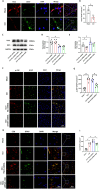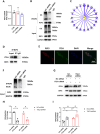MTOR Promotes Astrocyte Activation and Participates in Neuropathic Pain through an Upregulation of RIP3
- PMID: 39893345
- PMCID: PMC11787194
- DOI: 10.1007/s11064-025-04341-x
MTOR Promotes Astrocyte Activation and Participates in Neuropathic Pain through an Upregulation of RIP3
Abstract
Neuropathic pain (NP), a chronic pain condition, is the result of abnormalities in both central and peripheral pain conduction pathways. Here, we investigated the underlying mechanisms associated with this effect. We found that following chronic constriction injury (CCI) surgery, there was an increase of mTOR in astrocytes and an activation of astrocytes within the spinal cord. Pharmacological inhibition of mTOR reversed CCI-induced hyperalgesia and neuroinflammation. Moreover, knockdown of astrocytic mTOR rescued the downregulation of spinal glutamate metabolism-related protein expression, underscoring the pivotal role of mTOR in modulating this pathway. Intriguingly, we observed that overexpression of mTOR, achieved via intrathecal administration of TSC2-shRNA, led to an upregulation of RIP3. Notably, pharmacological inhibition of RIP3, while ineffective in modulating mTOR activation, effectively eliminated the mTOR-induced astrocyte activation. Mechanistically, we found that mTOR controlled the expression of RIP3 in astrocytes through ITCH-mediated ubiquitination and an autophagy-dependent degradation. Taken together, our results reveal an unanticipated link between mTOR and RIP3 in promoting astrocyte activation, providing new avenues of investigation directed toward the management and treatment of NP.
Keywords: Astrocyte; MTOR; Neuroinflammation; Neuropathic pain; RIP3.
© 2025. The Author(s).
Conflict of interest statement
Declarations. Competing Interests: The authors declare no competing interests. Ethics Approval: All study protocols were reviewed and approved by Laboratory Animal Ethical and Welfare Committee of Shandong University Cheeloo College of Medicine (Approval No. 23056). Consent to Participate: Not applicable. Consent for Publication: Consent to publish was obtained from the participants.
Figures








Similar articles
-
RIP3 Inhibition ameliorates chronic constriction injury-induced neuropathic pain by suppressing JNK signaling.Aging (Albany NY). 2021 Nov 12;13(21):24417-24431. doi: 10.18632/aging.203691. Epub 2021 Nov 12. Aging (Albany NY). 2021. PMID: 34772825 Free PMC article.
-
mTOR pathway is involved in ADP-evoked astrocyte activation and ATP release in the spinal dorsal horn in a rat neuropathic pain model.Neuroscience. 2014 Sep 5;275:395-403. doi: 10.1016/j.neuroscience.2014.06.030. Epub 2014 Jun 27. Neuroscience. 2014. PMID: 24976516
-
TRPM7 Mediates Neuropathic Pain by Activating mTOR Signaling in Astrocytes after Spinal Cord Injury in Rats.Mol Neurobiol. 2024 Aug;61(8):5265-5281. doi: 10.1007/s12035-023-03888-6. Epub 2024 Jan 5. Mol Neurobiol. 2024. PMID: 38180616
-
Spinal sigma-1 receptor activation increases the production of D-serine in astrocytes which contributes to the development of mechanical allodynia in a mouse model of neuropathic pain.Pharmacol Res. 2015 Oct;100:353-64. doi: 10.1016/j.phrs.2015.08.019. Epub 2015 Aug 24. Pharmacol Res. 2015. PMID: 26316425
-
Calcitonin gene-related peptide induces the histone H3 lysine 9 acetylation in astrocytes associated with neuroinflammation in rats with neuropathic pain.CNS Neurosci Ther. 2021 Nov;27(11):1409-1424. doi: 10.1111/cns.13720. Epub 2021 Aug 16. CNS Neurosci Ther. 2021. PMID: 34397151 Free PMC article.
References
-
- Finnerup NB, Kuner R, Jensen TS (2021) Neuropathic pain: from mechanisms to treatment. Physiol Rev 101(1):259–301. 10.1152/physrev.00045.2019 - PubMed
-
- Bannister K et al (2020) Neuropathic pain: mechanism-based therapeutics. Annu Rev Pharmacol Toxicol 60:257–274. 10.1146/annurev-pharmtox-010818-021524 - PubMed
-
- Baron R, Binder A, Wasner G (2010) Neuropathic pain: diagnosis, pathophysiological mechanisms, and treatment. Lancet Neurol 9(8):807–819. 10.1016/S1474-4422(10)70143-5 - PubMed
MeSH terms
Substances
Grants and funding
LinkOut - more resources
Full Text Sources
Research Materials
Miscellaneous

